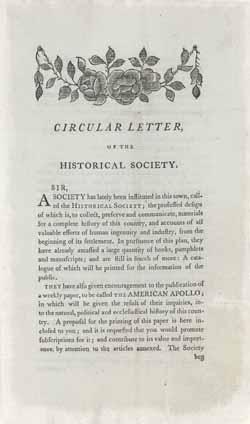Collections Online
Circular Letter, of the Historical Society
To order an image, navigate to the full
display and click "request this image"
on the blue toolbar.
-
Choose an alternate description of this item written for these projects:
- Object of the Month
- Witness to America's Past
- MHS Collecting History
- MHS 225th Anniversary
- Main description
[ This description is from the project: Staff Favorites ]
In January 1791, Rev. Jeremy Belknap invited nine like-minded Bostonians to create what they would call simply "the Historical Society," now the Massachusetts Historical Society—the oldest organization in the United States devoted to collecting materials for the study of American history. Ten months later, Belknap drafted the “Circular Letter, of the Historical Society,” announcing the new Society’s formation and its objectives, as well as soliciting donations. The goal of the Historical Society was "to collect, preserve, and communicate, materials for a complete history of this country." It has remained essentially unchanged for over two centuries.
“This letter remains relevant to our work…”
MHS Visitor Services Coordinator Laura Williams on Massachusetts Historical Society Circular Letter
I chose this item from our collections primarily because it is a call to our purpose as an institution. For over 200 years the Society has remained faithful to the "mission" presented in the letter: "to collect, preserve, and communicate, materials for a complete history of this country." After my first year as a member of the MHS team, I know this to be true. I have been welcomed and invited to work and assist various departments and continue this mission. I love that this letter remains relevant to our work and continues to be built upon in the present day.
I would love to know if the contributions that are made to the MHS still consist largely of the same categories that Jeremy Belknap requested back in 1791: colonial, revolutionary, and independent American history: town histories and genealogical records, wars and battles, personal narratives of suffering and captivities, histories of local churches, biographical memoirs, geographical, meteorological and topographical descriptions, census and vital records, modes of education, and commentaries on travel, navigation, manufacturing and commerce.

